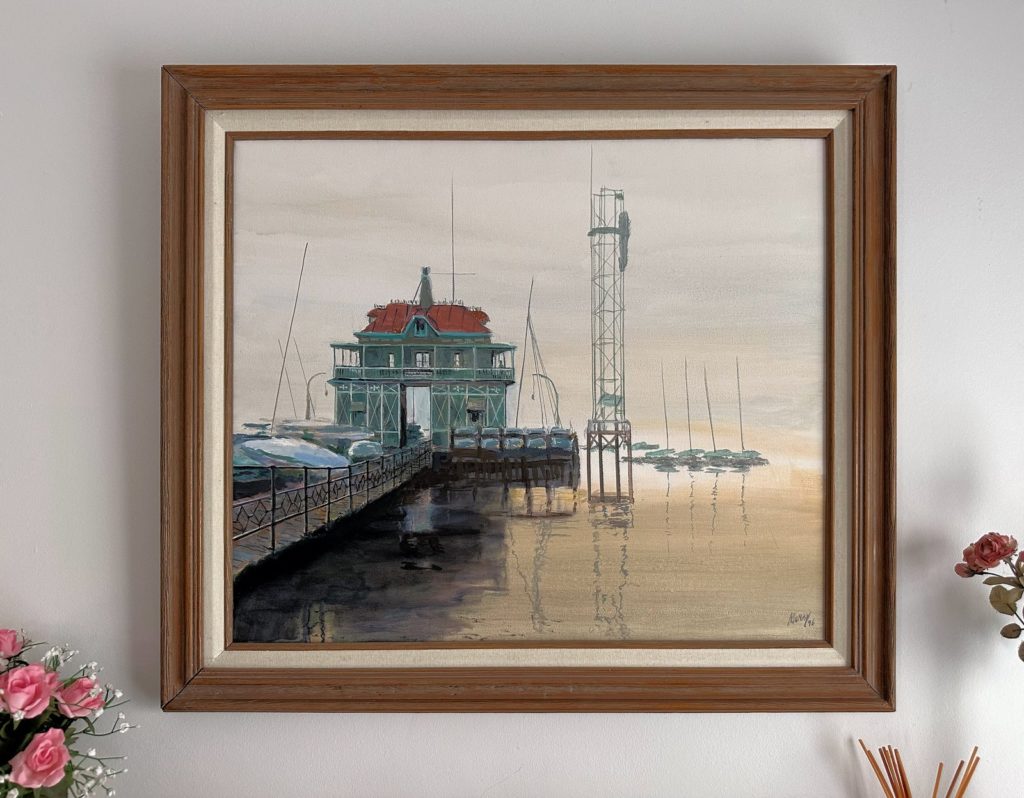 A chance viewing of a painting of the Riverton Yacht Club by William Munro at Marion Laffey‘s home led to this latest entry to our Local Artists tribute page.
A chance viewing of a painting of the Riverton Yacht Club by William Munro at Marion Laffey‘s home led to this latest entry to our Local Artists tribute page.
After some networking on our website and Facebook, we can fill in some sketchy details about this talented fine artist and will include more when we get more.
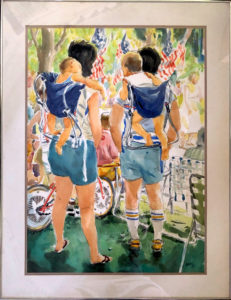
Deb Lengyel confirmed that William Munro was “phenomenally talented,” that his wife was a “gifted painter,” and that their daughter, Edith Munro, is “an amazing water-colorist, to this day.”
Chris Halt sent this photo of one piece.
Leigh Dickinson Bridge recalled that Mrs. Munro taught art at Palmyra High School.
Leah Bentcliff Falicki added that William created a mural at Palmyra High School, which set off Linda Horswood to ask a friend who works there to send some photos.
Tim Boyle responded, “Bill was a friend. I was fortunate to exhibit paintings in a few exhibits with him at the Thomas Margaret Gallery in Riverton. His wife was my art teacher in grade school.”
Tim sent these photos of pages from his friend’s sketchbook. He speculates that some drawings might be early sketches for the Palmyra High School murals, and other images are from his career as a commercial artist.
See, sometimes crowdsourcing works!
We welcome more biographical information and examples of artwork by any members of the talented Munro clan to fill in this virtual portfolio. -JMc
After Deb Lengyel clued me in about William and Jeanne’s daughter being an artist, I found her on Facebook and messaged her. I expected that she might send some info I’d have to edit, but instead, she sent the following heartwarming story, published here for the first time, just as she wrote it.
William K. Munro and Jeanne Munro
by Edith Munro
Growing up “Munro” in Riverton, NJ, was an experience that I believed, for a time, every other child must have simultaneously shared. Bill and Jeanne, my parents, created an environment that nurtured both creative and scientific pursuits long before anyone would create the label “STEM,” plus a very big “A” for art.
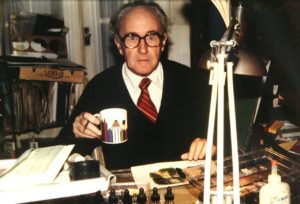
Our house was filled with art, music, and science experiments. Literally filled. Paintings hung on every bit of wall space. Bird feeders at the windows. My dad’s cluttered studio was jammed with art supplies and reference materials arranged in crusty old filing cabinets, mostly unwilling or unable to open their drawers to share their valuable information. Somehow, he managed to fit a very large drafting table into the space, where he could draw and paint, where he could paste up a catalog, or do technical drawings for his commercial clients.
Bill was from Baltimore, Maryland, and Jeanne was from Wilkes Barre, Pennsylvania. Both were born in 1918. Each of them created art from an early age, and it was this common interest that later brought them together. Bill’s family moved to Palmyra, NJ, in 1927, and he attended Palmyra High School, graduating in 1936. He continued his education at The Philadelphia Museum School of Industrial Art, where he met Jeanne, who was also in attendance. Their focus was in illustration.
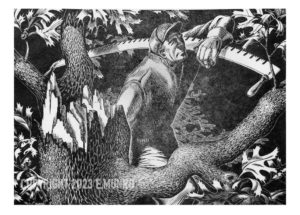
After their graduation, Bill was drafted into the Army and served with the 58th Medical Battalion (106th Infantry Division) in North Africa and Europe, and during that time, according to his family’s recollection, he carried a typewriter instead of a weapon.
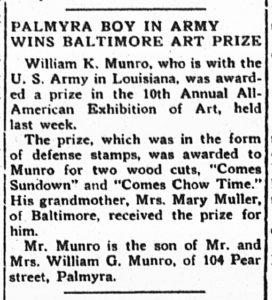
He was an unusual, subtly humorous guy, and he was well-liked by all. His artwork created during the war exhibits the pacifism in which he believed and passed along to his children. He also sketched numerous portraits of everyday life in the army. During this time, he somehow continued to paint and create wood engravings, often requesting art supplies be sent to him in his letters home.
Art, I believe, was his coping mechanism for being able to preserve his sanity while serving in what can only be described as either an unpleasant or horrific environment depending on the day. Bill recounted being within earshot, over the mountains from the “Battle of the Bulge.” What he painted, however, was a pastoral winter scene, a beautiful escapist manifestation.
At this time, Jeanne was in New York City, working at Bell Telephone Labs as a technical illustrator. She managed to experiment with glass blowing during her time there. New York availed her of all sorts of opportunities to experience art and science, albeit on a very limited budget for anyone in their first job. During these years, Bill and Jeanne communicated through numerous letters; often, those from Bill were works of art in themselves, nearly always adorned with a drawing or a cartoon.
Bill returned to the United States to marry Jeanne. They began to raise a family in Palmyra, where Bill’s parents still lived. They moved to Riverton the year that I was born. Bill worked at H.L.Yoh company in Philadelphia as a technical illustrator and art director. Bill’s work life enabled friendships with other artists and a social outlet, whereas Jeanne was responsible for raising the kids and keeping everyone fed!
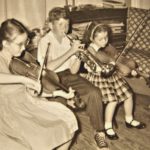
If you were one of us three Munro kids, you had to play at least one instrument and have one “collection.” For John, it was trumpet and insects. Judy’s was piano, violin, and seashells. Mine, the clarinet and piano, and the most ephemeral collection, feathers. Each choice developed a curiosity that would eventually come to define us, following these interests all of our lives.
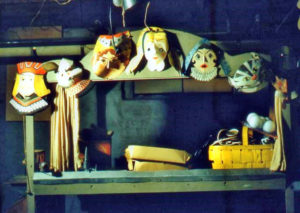
The two-foot-wide parabolic mirror in the famous “Munro” basement, which many people remember like it was a museum or maybe a carnival sideshow. It was a big draw when we wanted to impress our friends. There was also a collection of rocks, a rusty old tool for everything, jars of nails and hardware screwed to the ceiling, a homemade puppet stage, a vintage roller printing press, and a darkroom. All of these items were actually used in various pursuits.
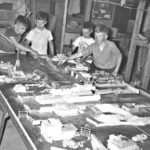
There was also a ping pong table with a set-up of home-crafted buildings and a model railroad on its playing surface, a hundred lost ping pong balls scattered and hiding in dusty corners. Later a light show with a repurposed sound system, thanks to my older brother, John. It was Edmund Scientific‘s local branch!
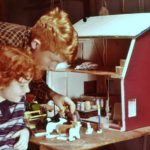
This is what my parents brought to the table, not just for the three of us kids, but whoever came in contact with us as friends, relatives, or students: a curiosity about nature, a love of the arts, a respect for study and practice, and the encouragement of self-expression.
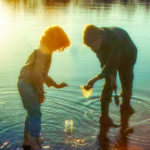
Family vacations were always spent painting along a riverbank, on a farm, hiking in the woods, or on the rockbound coast of Maine. All of these destinations created an inspiration to paint, as well as document landscapes or seascapes in photography, to later be used as a reference for painting at home.
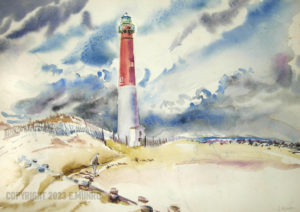
It was not uncommon for the whole family to be charged with sketching together or hiking together, identifying mushrooms or birds. I remember distinctly one hike in Sapsucker Woods in Ithaca, New York when we lost the trail while paying too much attention to the details and ultimately found our way back to the car in a swarm of ravenous mosquitos.
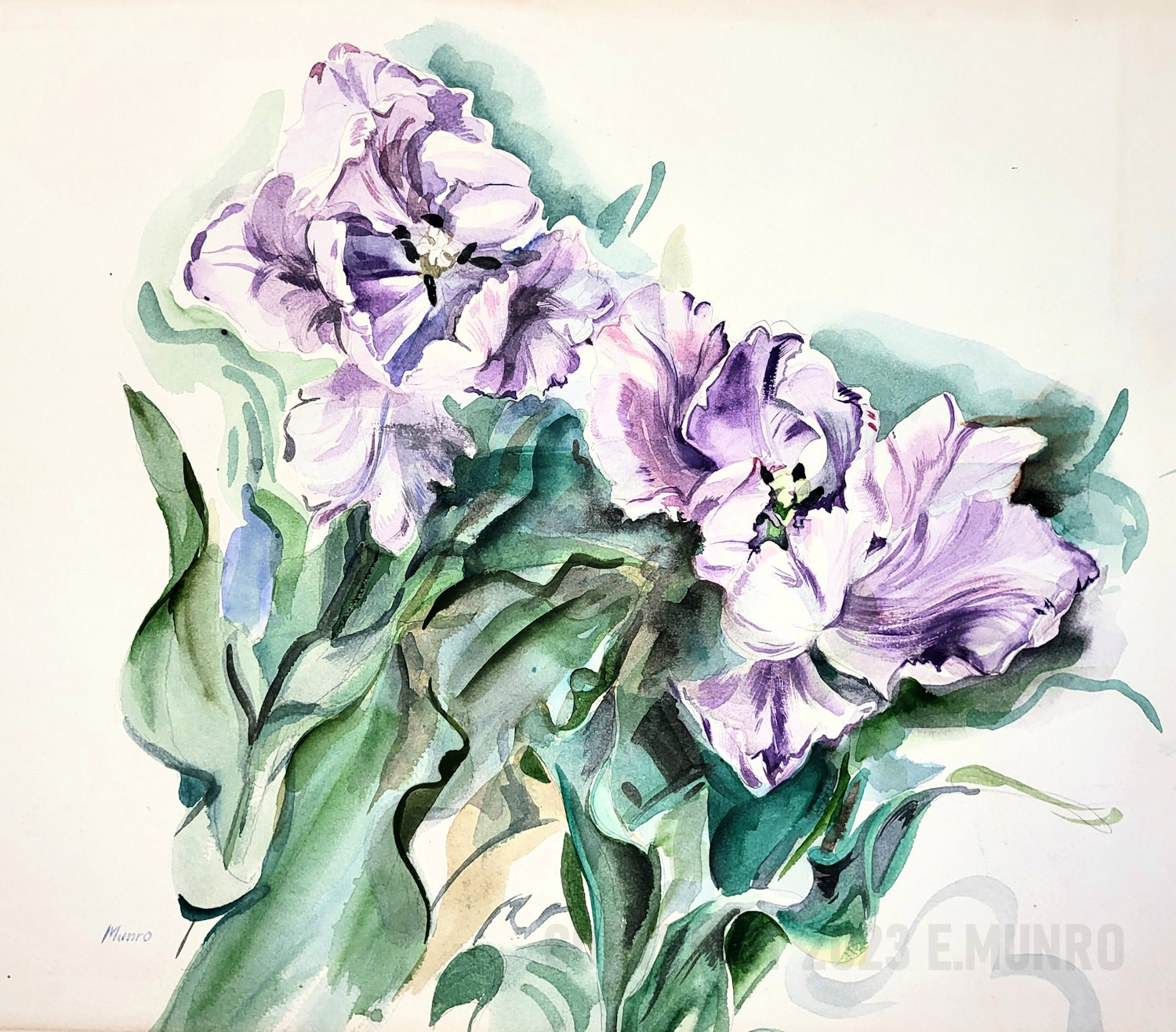
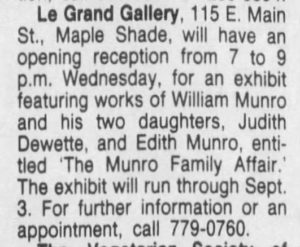
Bill and Jeanne were avid, accomplished watercolorists and spent what free time they had practicing their art, and staying active in the community art scene, sometimes exhibiting in local mall shows, the Philadelphia Art Alliance, as well as the Atlantic City Boardwalk Show, and the Perkins Center for the Arts in Moorestown, New Jersey.
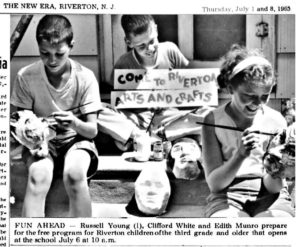
Jeanne would sometimes take night art classes at Fleisher in Philadelphia. In the 1960s, she was instrumental in developing an arts and crafts summer program at Riverton School and spent many years teaching and helping to run the program. She was always a very nurturing teacher, and her students often turned up at our door, where she was always generous with her time and an occasional treat.
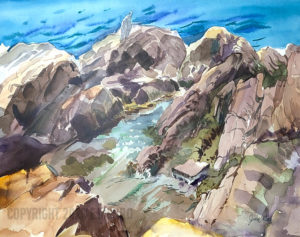
She then worked for many years in the 1960-1970s for the Palmyra School System as an art teacher, rotating between three elementary and middle schools. She simultaneously attended Rutgers Camden to earn a necessary teaching degree. She was well-liked by her students. I well remember the many hours she would spend cutting out shapes for sewing projects, setting up a studio for copper enameling, or tooling leather.
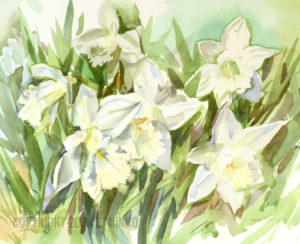
After her teaching career, she painted more often and dabbled in writing and illustrating a children’s book, which she never finished.
In 2020, at the beginning of the pandemic, I managed to scan in all of her drawings and fill the holes in her rough script, to create “The Always Way”, a story about a plucky squirrel who needs to find a safe way to a birdfeeder – a legacy for her grandchildren.
Jeanne passed away in 1986, paintings remaining unfinished on easels around the house.
Bill eventually become a freelancer and continued to keep his hands active in various branches of art production. The bread and butter of his career had been technical illustration, advertising, book, and catalog design. He also continued to experiment artistically with new subjects and media, whether it be abstractions or collages, sculpture, or acrylics. After my mom passed, he lived alone and would stack up the paintings on the two sofas in the living room, expectant of a visit from one of us kids or anyone who happened to drop by. There was no place to sit, but there was always quite an exhibition of new work!
Bill is known for his paintings of the Riverton Yacht Club and his seascapes. When he was in college, he painted the murals hanging in Palmyra High School, presented by his sister, Janet Munro’s class of 1940. Hundreds of students passed by the murals every day. In 1993 he was able to restore the paintings that adorned the main hall.
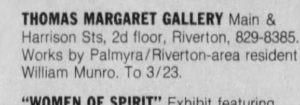
He has also received recognition in both the art of printmaking and watercolor. He has exhibited at the Baltimore Art Museum, the Philadelphia Art Alliance, and the Montclair Art Museum. Most recently, he was represented by the Thomas Margaret Gallery in Riverton. One set of regionalist-style prints is in the archives of the Baltimore Museum of Art.
Bill retired in 2000 and moved to Montclair, NJ, to live with his daughter, Judith. He lived a block away from Anderson Park and began sketching the trees in the park on his daily walks, getting to know each one individually and enjoying the natural beauty that provides balance and distraction to the otherwise bustling town of Montclair. He frequently, if not weekly, enjoyed painting workshops at his daughter Edith’s house. He passed away in 2007.
As I grew up, I thought everyone had a Mom and Dad like mine. It took years to figure out that wasn’t true. My Dad always retained a childlike enjoyment of life, even as he slaved to support us. My Mom was the realist and the nurturer. They were both imaginative, skilled, and innately talented artists who would effortlessly put pencil to paper and produce a masterpiece. This is not something that comes easily to all of us. Believe me, I know. But on the other hand, once in a while, I would wonder, “Where did the idea for that painting come from?”
Edith Munro
All images are copyrighted and used by permission of Edith Munro.
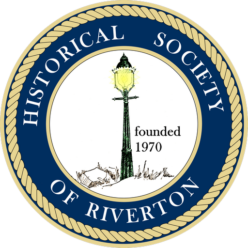
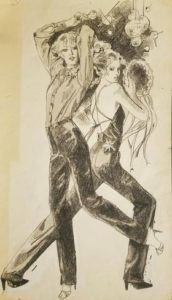
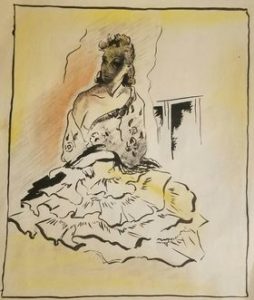
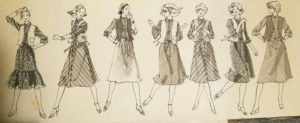

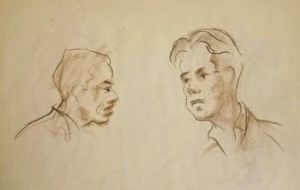
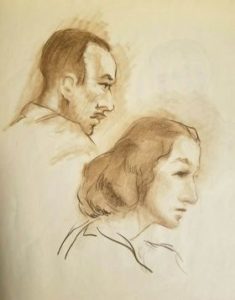

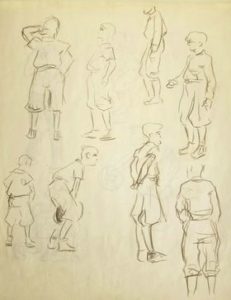


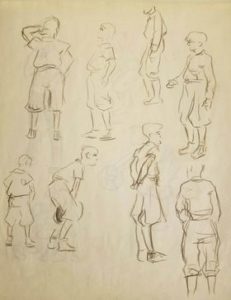
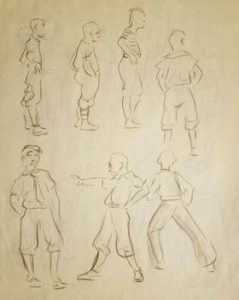
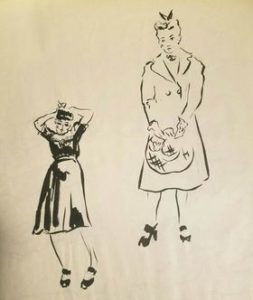
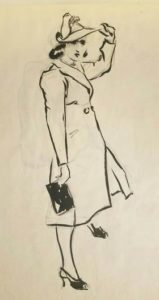
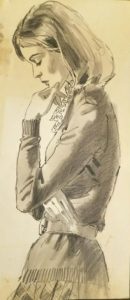


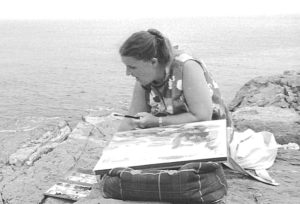

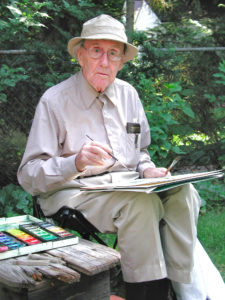
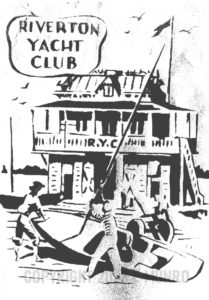
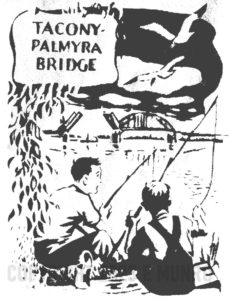
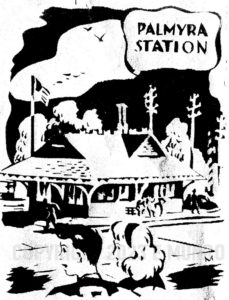



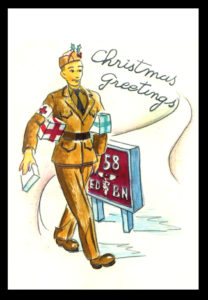
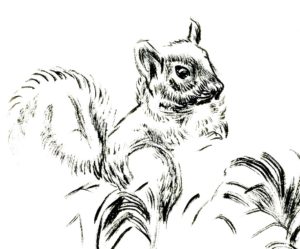

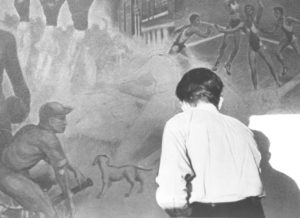


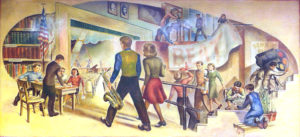

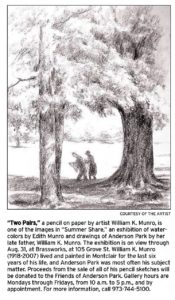
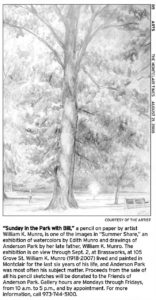

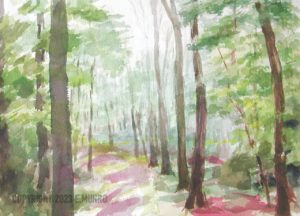
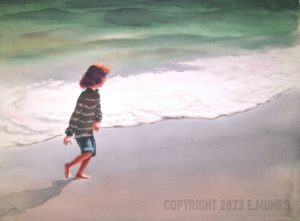
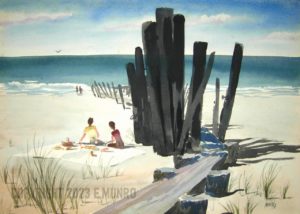
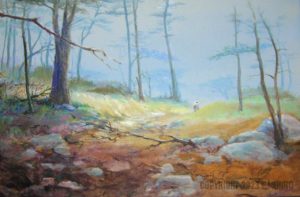
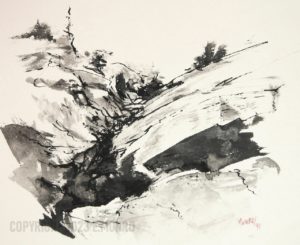

Wow, thanks very much for this article!
Welcome back, Jim. Since you left this comment, Edith Munro sent me some more photos that I placed within her essay.